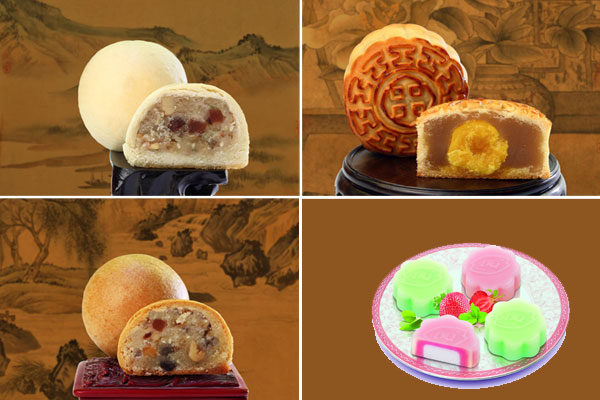
 |
|
Clockwise from above left: The zilaibai, Cantonese egg yolk with white lotus paste mooncakes, ice skin moon cake and zilaihong mooncakes. Photos provided to China Daily |
Although bakery products have changed through the years, some of the most popular recipes remain the original ones, Ye Jun reports.
Like any classic food, the Chinese moon cake has seen a lot of changes over time. But sometimes, traditional styles are still the most popular.
Beijinger Wang Junjie still likes the taste of zilaihong, a Beijing-style moon cake.
"When I was a kid, my family was so poor. We yearned for holidays such as the Mid-Autumn Festival, so that we could eat mooncakes," says the 55-year-old. "But now mooncakes are available year-round. It is like a holiday every day, so I no longer feel that special yearning."
Beijing's traditional mooncakes are zilaihong and zilaibai. The handmade, hard-crust mooncakes are made up of rock sugar, walnut kernels, pumpkin seeds and qinghongsi, candied tangerine peel slices. Zilaihong uses red sugar in the dough, while zilaibai uses white sugar. The taste is simple but pure.
Wang is a Chinese executive pastry chef at Summer Palace Chinese restaurant, China World Hotel. Under his supervision, the hotel produces 12 different moon cake gift boxes, with more than 30 flavors.
These boxes contain the most popular styles of mooncakes: Beijing, Su (Suzhou), Cantonese and Yunnan. They each have their own unique ingredients and combinations.
For example, Cantonese-style mooncakes typically use red lotus paste, white lotus paste and mashed bean stuffing. Mashed jujube is mostly Beijing style. Yunnan-style mooncakes use ham and rock sugar.
But over time, styles have changed, and people cannot always distinguish mooncakes by region.
"For instance, everybody uses five nuts for stuffing, no matter where they live," chef Wang says.
There are different stories about the origin of mooncakes, which are believed to be around 1,000 years old. The moon cake was an offering to the god of the moon, and for the Chinese the round shape means "reunion".
Lin Huoxiong, director of research and development with Imperial Palace Cantonese Restaurant, says Cantonese people always eat mooncakes with tea.
"It is usually paired with chrysanthemum, pu'er or tieguanyin (a Fujian oolong)," he says.
His restaurant, which opened in Beijing in 2002, makes both Cantonese-style mooncakes and a Chaozhou-style crispy crust moon cake adapted from a popular turnip crispy cake.
